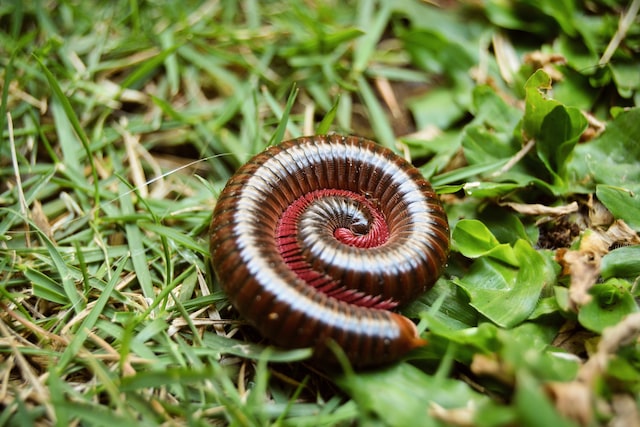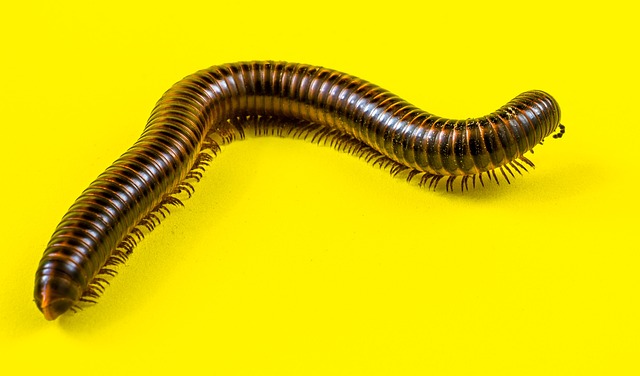Millipedes and centipedes are both are arthropods that have a segmented body with many pairs of legs, they differ in habitat, diet, coloration and behavior. Millipedes can be distinguished by their longer antennae and slower movement while centipedes can be identified by their shorter antennae and faster pace.
What are millipedes?

Millipedes are arthropods that are characterized by having two pairs of legs on each body segment. They are commonly found in damp environments and feed on decaying organic matter. Although they share many similarities with centipedes, millipedes are not as aggressive and do not have poison claws.
What are centipedes?
(Photo By Josch13 from Pixabay)

Centipedes are arthropods that have long, segmented bodies with many legs. They are predators that hunt small insects and other invertebrates. Centipedes are found in a variety of habitats all over the world.
The difference between millipedes and centipedes
Millipedes and centipedes are both arthropods, meaning they have jointed appendages and a hard exoskeleton. They are often confused for one another, but there are several key differences between the two.
For starters, millipedes have two pairs of legs per body segment while centipedes have only one pair. This may not seem like a big difference, but it means that millipedes move slower than centipedes. Centipedes are also carnivorous, meaning they eat other small insects and animals. Millipedes, on the other hand, are mostly herbivorous and feed on decaying vegetation.
Perhaps the most noticeable difference between millipedes and centipede is their size. Centipede can grow to be much larger than millipede, with some species reaching up to 12 inches in length! Millipede maximums out at around 6 inches in length.
So, next time you see a long, segmented creature scurrying along your floor, take a closer look to see if it’s a millipede or a centipede. And remember, although they may look scary, neither of these creatures is harmful to humans!
How to get rid of millipedes and centipedes
If you’ve found a millipede or centipede in your home, you may be wondering how to get rid of them. Here are some tips:

Which one is poisonous centipede or millipede?
There are more than 12,000 species of millipedes, and most of them are not poisonous. Only a small number of millipede species contain toxins that can harm humans. On the other hand, all centipede species are venomous. They use their fangs to inject venom into their prey. This venom can also be harmful to humans if injected through a bite.
Centipedes are predators that will hurt you if they can, whereas millipedes are mostly harmless herbivores. Millipedes do have two sharp claws at the front of their body which they use for self-defense, but these are not strong enough to pierce human skin. So, while millipedes can’t hurt you, they can startle you with their sudden movements and their ability to curl up into a tight ball when threatened.
What attracts millipedes in the house?
One of the main reasons millipedes end up in homes is because they are attracted to moist conditions. Millipedes are often found in gardens and flowerbeds because they like to eat decaying organic matter. If your home has any damp areas, such as a basement or crawlspace, it’s likely that millipedes will be drawn to it. You may also find them near leaky pipes or other sources of water.
How do I stop millipedes coming into my house?
If you’re noticing millipedes in your home, it’s likely they’ve come in from the outdoors through cracks and crevices around doors or windows. To help prevent them from getting inside, fill any cracks or openings with caulk or sealant. You can also try to keep the area around your home free of leaf litter, mulch, and other organic material that millipedes like to eat and hide in. If you have a persistent millipede problem, contact a pest management professional for assistance.
What keeps centipedes away?
There are a few things you can do to keep centipedes away from your home. First, make sure that your house is free of any food sources that might attract them. This means keeping your kitchen clean and free of crumbs and sealing up any cracks or holes where they might be able to get inside. You can also try using diatomaceous earth or a natural insecticide like neem oil around the perimeter of your home. Finally, make sure to keep your yard free of debris and clutter where centipedes could hide.
Frequently asked questions about millipedes and centipedes
Do millipedes lay eggs in houses?
Unlike centipedes, millipedes do not lay their eggs in houses. Instead, they deposit them in the soil, where they hatch into miniature versions of the adults. Female millipedes can lay anywhere from a dozen to several hundred eggs at a time, depending on the species.
What eats millipedes and centipedes?
Millipedes and centipedes are both eaten by a variety of predators. Lizards, snakes, toads, and birds all prey on these small animals. In addition, millipedes and centipedes can be eaten by larger invertebrates such as spiders and other predatory insects.
What kills millipedes instantly?
There are a few things that can kill millipedes instantly. Pesticides and herbicides are two of the most common. Both of these products contain chemicals that are poisonous to millipedes and can kill them quickly. Another thing that can kill millipedes is extreme cold. If they are exposed to temperatures below freezing, they will die almost immediately.
Does light keep centipedes away?
Yes, light does keep centipedes away. Centipedes are nocturnal creatures that prefer to stay hidden during the day. If you have a centipede problem, try turning on some lights in your home at night to deter them. You can also try using yellow or blue light bulbs, as these colors are less attractive to centipedes.
Do centipedes grow back if cut in half?
No, centipedes do not grow back if cut in half. If a centipede is cut in half, the two halves will die.
What time of year are millipedes and centipedes most active?
Millipedes and centipedes are most active in the spring and fall. In the spring, they come out of hiding to mate and lay eggs. In the fall, they are looking for food and a place to spend the winter.
Featured Image By – Vineeth Kumar on Unsplash









